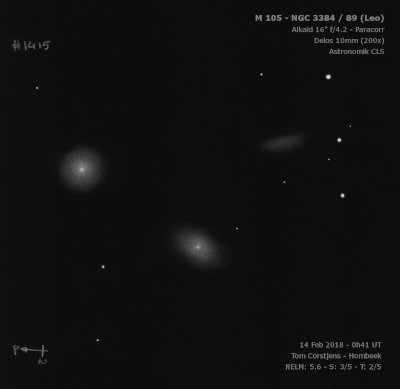
Pierre Méchain discovered M105 = H I-17 = h757 on 24 Mar 1781, four days after he discovered M95 and M96. It was discovered after Messier's final catalogue was sent to publication (in the 1784 Connaissance des temps) but was included in a letter dated 6 May 1783 to Johann Bernoulli, the editor of the Berliner Astronomisches Jahrbuch and published in the 1786 Jarbuch volume. Méchain wrote, "Mr. Messier reports in the Connoissance des temps 1784, p. 264 & 265 two nebulous stars, which I have discovered in the Leo M95 and M96]; I find nothing to change for my positions which I have established by comparing these nebulae to Regulus; but there is also a third one to the north; it is a bit more beautiful [brighter] than the 2 others; I have discovered it on March 24, 1781, 4 or 5 days after the other two. On April 10, I compared it to Gamma Leonis & I have concluded the right ascension 159d 3' 45"; the declination 13d 43' 58" north."
William Herschel independently found M105 on 11 Mar 1784 (sweep 164) and recorded "Three nebula in the field together [with NGC 3384 and 3389]. The two preceding ones [M105 and NGC 3384] cometic and much like the two former bright ones M95 and M96], but considerably less." John Herschel's earliest observation was on 10 Apr 1825 (sweep 2). The NGC position is accurate (measured by Auwers and d'Arrest).
200/250mm - 8" (3/28/81): fairly bright, round.
300/350mm - 13.1" (2/25/84): bright, very small bright core, slightly elongated. First of three bright galaxies in the field with NGC 3384 7.3' NW and NGC 3389 9.7' ESE.
600/800mm - 24" (4/20/14): very bright, large, slightly elongated ~SW-NE, ~3.0'x2.5'. Sharply concentrated with a large, brilliant core containing to an intense nucleus, which increases towards the center. First in a prominent trio with NGC 3384 7.3' NW and NGC 3389 9.8' ESE. M105 is a member of the M96 or Leo I Group (LGG 217), along with NGC 3384.
Notes by Steve Gottlieb